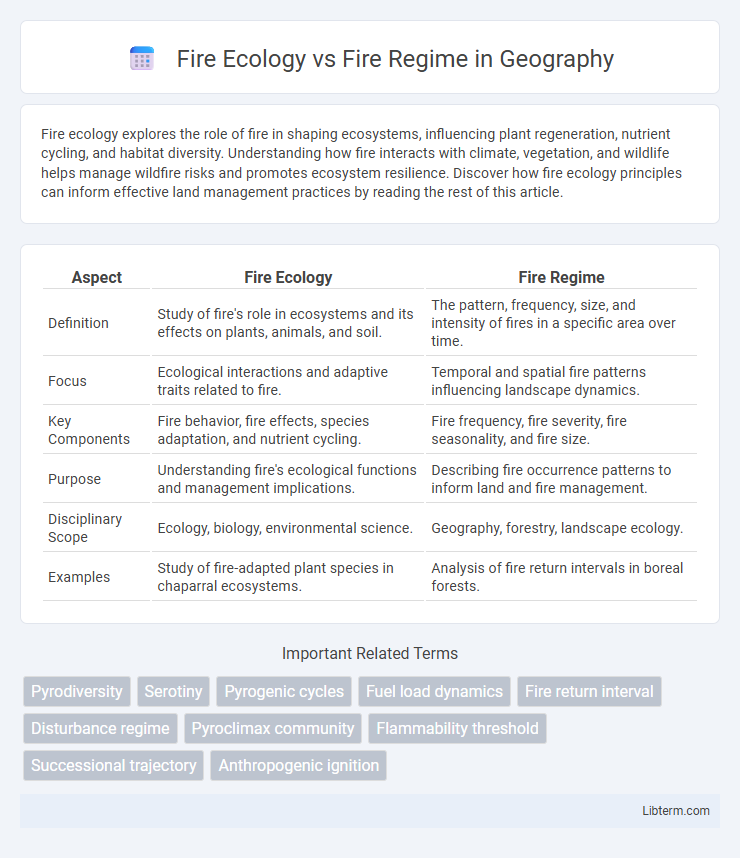Fire ecology explores the role of fire in shaping ecosystems, influencing plant regeneration, nutrient cycling, and habitat diversity. Understanding how fire interacts with climate, vegetation, and wildlife helps manage wildfire risks and promotes ecosystem resilience. Discover how fire ecology principles can inform effective land management practices by reading the rest of this article.
Table of Comparison
| Aspect | Fire Ecology | Fire Regime |
|---|---|---|
| Definition | Study of fire's role in ecosystems and its effects on plants, animals, and soil. | The pattern, frequency, size, and intensity of fires in a specific area over time. |
| Focus | Ecological interactions and adaptive traits related to fire. | Temporal and spatial fire patterns influencing landscape dynamics. |
| Key Components | Fire behavior, fire effects, species adaptation, and nutrient cycling. | Fire frequency, fire severity, fire seasonality, and fire size. |
| Purpose | Understanding fire's ecological functions and management implications. | Describing fire occurrence patterns to inform land and fire management. |
| Disciplinary Scope | Ecology, biology, environmental science. | Geography, forestry, landscape ecology. |
| Examples | Study of fire-adapted plant species in chaparral ecosystems. | Analysis of fire return intervals in boreal forests. |
Introduction to Fire Ecology and Fire Regime
Fire ecology studies the role and effects of fire within ecosystems, examining how fire shapes plant communities, animal habitats, and nutrient cycles. Fire regime refers to the patterns, frequency, intensity, and seasonality of fires in a specific area, influencing ecosystem structure and function. Understanding fire regimes is essential for fire ecology research, as it provides insights into natural fire cycles and their impact on biodiversity and land management.
Defining Fire Ecology
Fire ecology examines the role and impact of fire within ecosystems, studying how fire influences species composition, nutrient cycling, and habitat structure. It highlights fire as a natural process essential for maintaining biodiversity and ecosystem resilience. Understanding fire ecology aids in managing landscapes for sustainable fire regimes that support ecological balance and reduce wildfire risks.
Understanding Fire Regime
Fire regime describes the patterns, frequency, intensity, and types of fires that occur in a specific ecosystem over an extended period. Understanding fire regimes involves analyzing factors such as fire return intervals, seasonality, and spatial distribution, which influence vegetation dynamics and ecosystem resilience. This knowledge aids in predicting fire behavior and informs effective management strategies for maintaining ecological balance.
Key Differences Between Fire Ecology and Fire Regime
Fire ecology studies the interactions between fire and ecosystems, focusing on how fire influences species composition, nutrient cycling, and habitat structures. Fire regime refers to the patterns of fire occurrence, including frequency, intensity, size, and seasonality, shaping long-term landscape dynamics. The key difference lies in fire ecology emphasizing biological and ecological responses to fire, while fire regime analyzes the characteristic behaviors and temporal patterns of fires within a specific area.
Components of Fire Regimes
Fire regimes consist of key components such as fire frequency, intensity, seasonality, and spatial pattern, which collectively influence ecosystem dynamics and species adaptation. Fire ecology studies how these components shape vegetation structure, nutrient cycling, and wildlife habitats over time. Understanding fire regimes enables effective management of fire-prone landscapes by balancing ecological benefits and risks.
The Role of Fire in Ecosystem Dynamics
Fire ecology studies how fire influences the structure, composition, and function of ecosystems, emphasizing fire's role in nutrient cycling, species adaptation, and habitat diversity. Fire regimes describe the patterns, frequency, intensity, and seasonality of fires in a specific ecosystem, shaping vegetation dynamics and animal populations over time. Understanding both fire ecology and fire regimes is crucial for managing landscapes, restoring habitats, and enhancing ecosystem resilience against changing fire frequencies due to climate change.
Effects of Fire on Biodiversity
Fire ecology examines how fire influences ecosystems and biodiversity by shaping habitat structure, nutrient cycling, and species composition; it highlights adaptive traits in fire-dependent flora and fauna. Fire regime refers to the patterns, frequency, intensity, and seasonality of fires in a region, which directly affect biodiversity outcomes by either maintaining species diversity or causing habitat loss. Variations in fire regimes can lead to shifts in community dynamics, promoting fire-adapted species while reducing fire-sensitive populations, ultimately influencing overall ecosystem resilience.
Human Influences on Fire Ecology and Regimes
Human activities significantly alter fire ecology by changing vegetation patterns, fuel loads, and fire frequency, leading to shifts in ecosystem resilience and species composition. Urban expansion, land-use changes, and fire suppression policies disrupt natural fire regimes, often resulting in more intense and severe wildfires. These anthropogenic influences necessitate adaptive management strategies to restore fire-adapted landscapes and maintain ecological balance.
Fire Management Strategies
Fire ecology examines the natural role and effects of fire in ecosystems, while fire regime details the patterns of fire frequency, intensity, and seasonality in a specific area. Fire management strategies leverage knowledge of fire regimes to implement controlled burns, fuel reduction, and wildfire suppression tailored to preserve ecosystem health and reduce hazardous fuel loads. Understanding both concepts is critical for developing adaptive fire management practices that enhance resilience to climate change and protect biodiversity.
Future Perspectives in Fire Science
Future perspectives in fire science emphasize integrating advanced remote sensing and machine learning to enhance understanding of fire ecology, enabling predictive modeling of vegetation responses and ecosystem resilience. Researchers focus on refining fire regime characterizations by incorporating climate change projections, increased disturbance frequency, and altered fire severity patterns to inform adaptive management strategies. Innovations in genomic tools and landscape-scale simulations are expected to revolutionize assessments of post-fire recovery and biodiversity conservation in fire-prone ecosystems.
Fire Ecology Infographic

 libterm.com
libterm.com